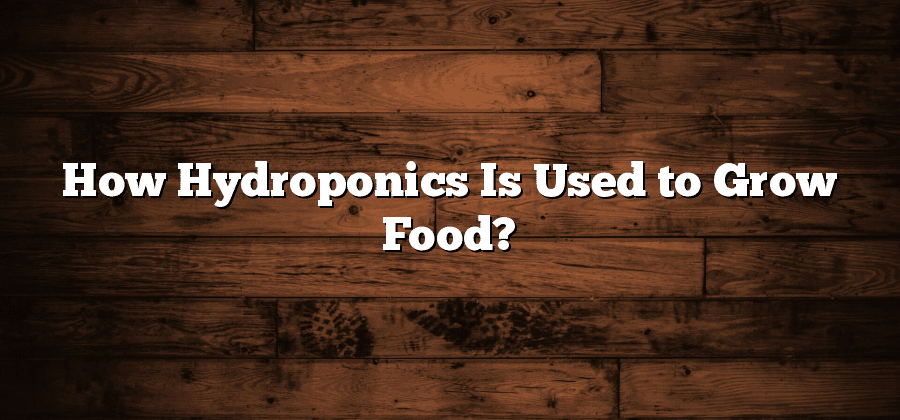Advantages of Hydroponics in Food Production
Hydroponics, a soil-less method of farming, has gained significant popularity in the field of food production due to its numerous advantages. One major advantage is the significant improvement in crop yield that hydroponics offers. By providing plants with the exact amount of nutrients they need, growth is maximized and there is no competition for resources. This results in healthier and more robust plants, which in turn leads to higher yields compared to traditional soil-based farming.
Another advantage of hydroponics is its ability to save water. Unlike traditional soil farming, where water can be wasted through evaporation or run-off, hydroponics allows for precise delivery of water directly to the plant’s roots. This targeted watering system ensures that water is not wasted and that the plants receive the exact amount they need. As a result, hydroponics can decrease water usage by up to 90% compared to traditional farming methods, making it an eco-friendly alternative in water-scarce areas.
Overall, the advantages of hydroponics in food production are evident through the increased crop yields and efficient use of water. This method of farming shows great potential in addressing the challenges of producing food in a sustainable and resource-efficient manner. As researchers and farmers continue to experiment and optimize hydroponic systems, it is likely that its benefits will only continue to grow, making it a crucial component in the future of agriculture.
Different Types of Hydroponic Systems
Hydroponics, a soil-less method of growing plants, offers various types of systems for cultivation. These systems provide flexibility and customization, catering to different plant needs and growing conditions. The first type is the Nutrient Film Technique (NFT) system. In this system, a thin film of nutrient-rich water continuously flows over the roots of the plants, providing them with essential nutrients for growth. This method ensures a constant supply of nutrients and oxygen, which results in healthy and robust plants. Another type is the Deep Water Culture (DWC) system, where the plant’s roots are submerged in a nutrient solution. This method allows for optimal oxygenation of the roots, promoting rapid growth and high yields.
Another widely used hydroponic system is the Ebb and Flow, also known as Flood and Drain. This system works by periodically flooding the plant’s roots with a nutrient solution and then allowing it to drain away. This cycle of flooding and draining ensures that the roots have access to both nutrients and oxygen, resulting in optimal plant growth. Additionally, the Drip System, a commonly used hydroponic system, involves delivering nutrient solution directly to the plant’s roots using drip emitters. This method allows for precise control over the nutrient supply to each plant, ensuring efficient nutrient uptake and reducing waste.
Each type of hydroponic system has its own advantages and considerations. By choosing the right system for specific plants and growing conditions, hydroponic farmers can optimize their production and achieve high-quality yields.
Essential Nutrients for Hydroponic Plants
Nutrients play a crucial role in the growth and development of hydroponic plants. Unlike traditional soil-based farming, hydroponic systems rely on a nutrient solution to provide plants with essential elements for their overall health and productivity. These nutrients are divided into two main categories: macronutrients and micronutrients. Macronutrients are required in relatively larger quantities, while micronutrients are needed in smaller amounts.
The three primary macronutrients include nitrogen (N), phosphorus (P), and potassium (K), commonly referred to as NPK. Nitrogen is responsible for promoting leaf and stem growth, phosphorus aids in the development of strong roots and promotes flowering and fruiting, whereas potassium enhances overall plant health and helps regulate important physiological functions. Micronutrients, on the other hand, are essential for the proper functioning of plants at a cellular level. These include elements such as iron (Fe), zinc (Zn), manganese (Mn), copper (Cu), boron (B), and molybdenum (Mo). Adequate levels of these micronutrients are required for optimal plant growth and metabolism.
In order to ensure the availability of these essential nutrients, hydroponic growers need to carefully monitor and maintain the nutrient solution. Regular testing and adjustment of nutrient levels is necessary to prevent deficiencies or toxicities, which can significantly impact plant growth and yield. Additionally, it is important to note that different plant species have varying nutrient requirements. Therefore, growers should tailor the nutrient solution to meet the specific needs of their crops. By providing the right balance of essential nutrients, hydroponic systems can effectively support the growth of healthy and productive plants.
Optimal Conditions for Hydroponic Growth
Hydroponics is a method of growing plants without the use of soil, instead, relying on a nutrient-rich water solution. To achieve optimal conditions for hydroponic growth, certain factors need to be carefully considered and controlled.
Firstly, light is a crucial element for the success of hydroponic plants. Providing the correct intensity and spectrum of light is essential for photosynthesis, which in turn drives plant growth. Different types of plants have varying light requirements, and it is crucial to ensure that they receive the appropriate amount of light each day. Artificial light sources, such as LED lights, can be used to mimic natural sunlight and provide the necessary light intensity for hydroponic plants.
Secondly, maintaining the right temperature is critical in hydroponics. Most hydroponic plants thrive in temperatures ranging between 68°F (20°C) to 86°F (30°C). Higher temperatures can cause stress and lead to stunted growth, while lower temperatures can slow down metabolism. Ensuring proper temperature control within this range creates an optimal environment for hydroponic plants to flourish.
As the article continues, it will explore other important aspects of optimal conditions for hydroponic growth, such as pH levels, humidity, and oxygenation. By carefully managing these factors, hydroponic growers can maximize the potential of their crops and achieve high yields.






